The drug taste masking technologies market is valued at USD 1,226.3 million in 2025 and is slated to reach USD 2,114.6 million by 2035, recording an absolute increase of USD 888.3 million over the forecast period. This translates into a total growth of 72.4%, with the market forecast to expand at a CAGR of 5.6% between 2025 and 2035.
The market size is expected to grow by approximately 1.72X during the same period, supported by increasing demand for patient-friendly pharmaceutical formulations, growing adoption of advanced coating technologies across pharmaceutical and biotechnology sectors, and rising preference for palatable drug delivery solutions in pediatric and geriatric applications.
The drug taste masking technologies market represents a specialized segment of the global pharmaceutical formulation industry, characterized by technological innovation and robust demand across pharmaceutical manufacturers, CDMOs/CROs, and academic research channels. Market dynamics are influenced by evolving patient compliance paradigms toward acceptable taste profiles, growing interest in pediatric-friendly formulations, and expanding partnerships between technology providers and pharmaceutical companies in developed and emerging economies. Traditional bitter drug formulations continue evolving as manufacturers seek proven taste masking alternatives that offer enhanced patient acceptability and reliable therapeutic characteristics.
Formulation behavior in the drug taste masking technologies market reflects broader pharmaceutical trends toward patient-centric systems that provide both therapeutic effectiveness benefits and extended compliance improvements. The market benefits from the growing popularity of coating and film-barrier applications, which are recognized for their superior masking properties and manufacturing compatibility across pharmaceutical and biotechnology applications. The versatility of taste masking technologies as both standalone formulation solutions and integrated drug delivery components supports demand across multiple pharmaceutical applications and therapeutic segments.
Regional adoption patterns vary significantly, with North American markets showing strong preference for pharmaceutical manufacturer implementations, while European markets demonstrate increasing adoption of CDMO applications alongside conventional research systems. The pharmaceutical landscape continues to evolve with sophisticated and targeted masking products gaining traction in mainstream operations, reflecting manufacturer willingness to invest in proven formulation technology improvements and patient-oriented features.
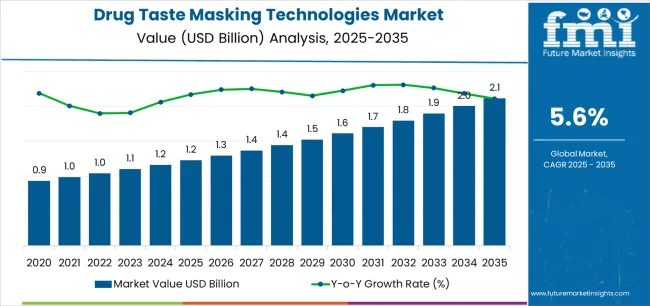
Drug Taste Masking Technologies Market Key Takeaways
| Metric | Value |
|---|---|
| Estimated Value (2025E) | USD 1,226.3 million |
| Forecast Value (2035F) | USD 2,114.6 million |
| Forecast CAGR (2025 to 2035) | 5.6 % |
Between 2025 and 2030, the drug taste masking technologies market is projected to expand from USD 1,226.3 million to USD 1,641.8 million, resulting in a value increase of USD 415.5 million, which represents 46.8% of the total forecast growth for the decade. This phase of development will be shaped by increasing adoption of coating barrier systems, rising demand for pharmaceutical manufacturing solutions, and growing emphasis on patient compliance features with advanced masking characteristics. Manufacturing facilities are expanding their formulation capabilities to address the growing demand for specialized masking implementations, advanced technology options, and application-specific offerings across pharmaceutical segments.
Between 2020 and 2025, the drug taste masking technologies market experienced steady growth, driven by increasing demand for coating barrier systems and growing recognition of patient compliance technologies as essential components for modern pharmaceutical development across manufacturing and research applications. The market developed as pharmaceutical companies recognized the potential for taste masking solutions to provide both compliance benefits and operational advantages while enabling streamlined formulation protocols. Technological advancement in coating processes and application-based development began emphasizing the critical importance of maintaining therapeutic efficacy and patient acceptability in diverse pharmaceutical environments.
From 2030 to 2035, the market is forecast to grow from USD 1,641.8 million to USD 2,114.6 million, adding another USD 472.8 million, which constitutes 53.2% of the overall ten-year expansion. This period is expected to be characterized by the expansion of biotechnology applications, the integration of innovative coating solutions, and the development of specialized masking implementations with enhanced technology profiles and extended formulation capabilities. The growing adoption of advanced formulation technologies will drive demand for drug taste masking systems with superior masking characteristics and compatibility with modern pharmaceutical technologies across manufacturing operations.
Market expansion is being supported by the increasing global demand for patient-friendly pharmaceutical formulations and the corresponding need for masking technologies that can provide superior palatability benefits and compliance advantages while enabling enhanced therapeutic delivery and extended compatibility across various pharmaceutical and biotechnology applications. Modern pharmaceutical manufacturers and formulation specialists are increasingly focused on implementing proven masking technologies that can deliver effective taste concealment, minimize traditional palatability limitations, and provide consistent performance throughout complex formulation configurations and diverse patient conditions. Drug taste masking technologies proven ability to deliver exceptional patient acceptability against traditional alternatives, enable advanced pharmaceutical integration, and support modern compliance protocols makes it an essential component for contemporary pharmaceutical and biotechnology operations.
The growing emphasis on patient-centric formulation and compliance optimization is driving demand for masking systems that can support complex formulation requirements, improve patient outcomes, and enable advanced pharmaceutical delivery. Manufacturer preference for technologies that combine effective taste masking with proven stability and formulation enhancement benefits is creating opportunities for innovative masking implementations. The rising influence of pediatric and geriatric medicine trends and patient compliance awareness is also contributing to increased demand for drug taste masking technologies that can provide advanced features, seamless pharmaceutical integration, and reliable performance across extended therapeutic cycles.
The drug taste masking technologies market is poised for steady growth and technological advancement. As pharmaceutical facilities across North America, Europe, Asia-Pacific, and emerging markets seek technologies that deliver exceptional masking characteristics, advanced formulation capabilities, and reliable manufacturing options, masking solutions are gaining prominence not just as specialty additives but as strategic enablers of compliance technologies and advanced pharmaceutical functionality.
Rising coating barrier adoption in pharmaceutical applications and expanding biotechnology enhancement initiatives globally amplify demand, while manufacturers are leveraging innovations in formulation engineering, advanced coating integration, and compliance optimization technologies.
The market is segmented by type, technology, end user, and region. By type, the market is divided into taste-masking excipients, coating polymers, encapsulation materials, processing equipment, and services categories. By technology, it covers coating & film-barrier systems, microencapsulation, hot-melt extrusion, organoleptic methods, and others segments. By end user, it encompasses pharmaceutical manufacturers, CDMOs/CROs, academic & research institutes, biotechnology companies, and others segments. Regionally, the market is divided into North America, Europe, East Asia, South Asia & Pacific, Latin America, and the Middle East & Africa.
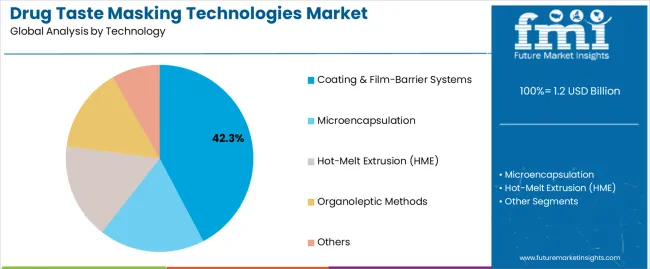
The coating & film-barrier systems segment is projected to account for 42.3% of the drug taste masking technologies market in 2025, reaffirming its position as the leading technology category. Pharmaceutical facilities and formulation integrators increasingly utilize coating barrier implementations for their superior masking characteristics when operating across diverse formulation platforms, excellent barrier properties, and widespread acceptance in applications ranging from basic taste masking to premium pharmaceutical operations. Coating barrier technology's established formulation methods and proven masking capabilities directly address the facility requirements for dependable masking solutions in complex pharmaceutical environments.
This technology segment forms the foundation of modern pharmaceutical adoption patterns, as it represents the implementation with the greatest market penetration and established formulator acceptance across multiple therapeutic categories and patient segments. Facility investments in coating barrier standardization and masking consistency continue to strengthen adoption among pharmaceutical manufacturers and biotechnology companies. With formulators prioritizing masking efficacy and manufacturing compatibility, coating barrier implementations align with both functionality preferences and cost expectations, making them the central component of comprehensive taste masking strategies.
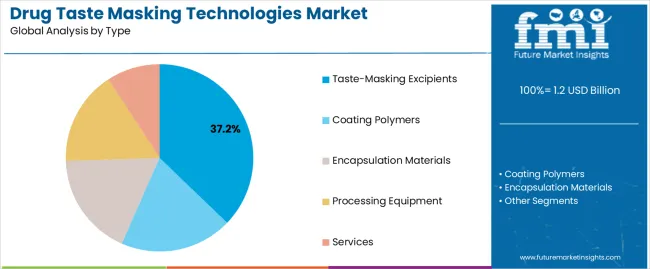
Taste-masking excipient applications are projected to represent 37.2% of drug taste masking technologies demand in 2025, underscoring their critical role as the primary type for masking delivery across pharmaceutical formulation operations. Pharmaceutical facilities prefer taste-masking excipients for drug formulation use for their exceptional masking characteristics, scalable formulation options, and ability to enhance palatability while ensuring consistent therapeutic quality throughout diverse pharmaceutical platforms and formulation operations. Positioned as essential masking components for modern pharmaceutical systems, excipient solutions offer both technological advantages and formulation efficiency benefits.
The segment is supported by continuous innovation in excipient technologies and the growing availability of specialized implementations that enable diverse formulation requirements with enhanced masking uniformity and extended patient acceptability capabilities. Pharmaceutical facilities are investing in advanced technologies to support large-scale formulation integration and product development. As patient compliance trends become more prevalent and acceptability awareness increases, taste-masking excipient applications will continue to represent a major implementation market while supporting advanced pharmaceutical utilization and technology integration strategies.
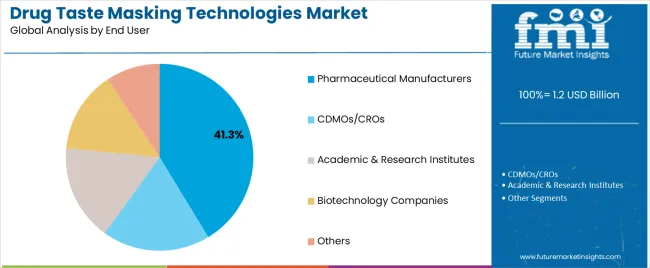
The pharmaceutical manufacturers segment is expected to capture 41.3% of the drug taste masking technologies market in 2025, driven by increasing demand for patient-friendly formulations that enhance compliance while maintaining therapeutic efficacy. Pharmaceutical manufacturers are increasingly adopting taste masking technologies for pediatric medications, oral dosage forms, and specialty therapeutics due to their superior palatability improvement and patient acceptance benefits. The segment benefits from growing regulatory emphasis on patient-centric drug development and continuous innovation in masking formulations tailored for pharmaceutical applications.
The drug taste masking technologies market is advancing steadily due to increasing demand for patient-friendly pharmaceutical formulations and growing adoption of masking systems that provide superior palatability characteristics and compliance benefits while enabling enhanced therapeutic delivery across diverse pharmaceutical and biotechnology applications. The market faces challenges, including complex regulatory requirements for taste masking agents, evolving safety standards, and the need for specialized formulation expertise and quality programs. Innovation in masking approaches and advanced coating systems continues to influence product development and market expansion patterns.
Expansion of Patient Compliance Technologies and Pharmaceutical Integration
The growing adoption of advanced patient compliance solutions, sophisticated masking capabilities, and therapeutic outcome awareness is enabling pharmaceutical developers to produce advanced masking solutions with superior palatability positioning, enhanced formulation profiles, and seamless integration functionalities. Advanced compliance systems provide improved patient outcomes while allowing more efficient pharmaceutical workflows and reliable performance across various formulation applications and therapeutic conditions. Developers are increasingly recognizing the competitive advantages of pharmaceutical integration capabilities for market differentiation and technology positioning.
Integration of Advanced Coating Methods and Formulation Engineering
Modern masking manufacturers are incorporating advanced coating technology, formulation integration, and sophisticated pharmaceutical solutions to enhance product appeal, enable intelligent masking features, and deliver value-added solutions to pharmaceutical customers. These technologies improve masking performance while enabling new market opportunities, including multi-layer coating systems, optimized excipient treatments, and enhanced palatability characteristics. Advanced formulation integration also allows developers to support comprehensive pharmaceutical technologies and market expansion beyond traditional masking approaches.
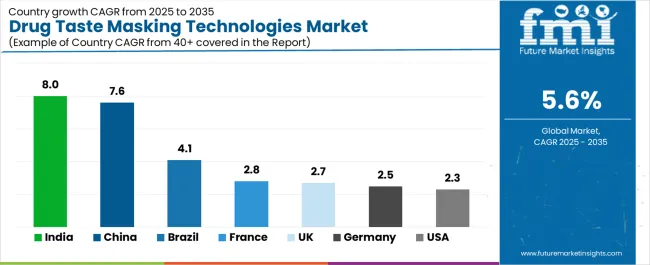
| Country | CAGR (2025-2035) |
|---|---|
| India | 8.0% |
| China | 7.6% |
| Brazil | 4.1% |
| France | 2.8% |
| UK | 2.7% |
| Germany | 2.5% |
| USA | 2.3% |
The drug taste masking technologies market is experiencing varied growth globally, with India leading at a 8.0% CAGR through 2035, driven by expanding pharmaceutical infrastructure, growing generic drug manufacturing programs, and significant investment in formulation technology development. China follows at 7.6%, supported by increasing pharmaceutical modernization, growing formulation integration patterns, and expanding biotechnology infrastructure. Brazil shows growth at 4.1%, emphasizing pharmaceutical innovation leadership and masking development.
France records 2.8%, focusing on expanding pharmaceutical capabilities and formulation technology modernization. The UK exhibits 2.7% growth, emphasizing pharmaceutical excellence and premium masking development. Germany demonstrates 2.5% growth, prioritizing advanced pharmaceutical development and quality-focused formulation patterns. The USA shows 2.3% growth, supported by pharmaceutical innovation initiatives and masking technology development.
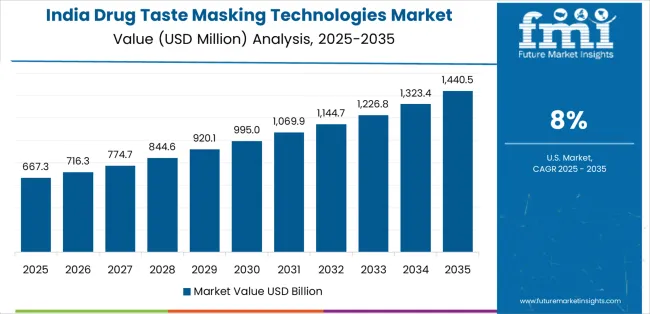
Revenue from drug taste masking technologies in India is projected to exhibit robust growth with a CAGR of 8.0% through 2035, driven by expanding pharmaceutical infrastructure capacity and rapidly growing generic manufacturing supported by government initiatives promoting formulation technology development. The country's improving pharmaceutical capabilities and increasing investment in masking infrastructure are creating substantial demand for advanced masking implementations. Major pharmaceutical facilities and technology companies are establishing comprehensive formulation capabilities to serve both domestic pharmaceutical demand and expanding export markets.
Government support for pharmaceutical innovation initiatives and generic development is driving demand for advanced masking systems throughout major pharmaceutical regions and manufacturing centers across the country. Strong pharmaceutical growth and an expanding network of formulation-focused producers are supporting the rapid adoption of drug taste masking technologies among facilities seeking advanced palatability capabilities and integrated formulation technologies.
Demand for drug taste masking technologies in China is growing at a CAGR of 7.6%, driven by the country's expanding pharmaceutical sector, growing manufacturing capacity, and increasing adoption of advanced formulation technologies. The country's initiatives promoting pharmaceutical modernization and growing formulation development awareness are driving requirements for technology-integrated masking systems. International masking providers and domestic pharmaceutical companies are establishing extensive manufacturing and integration capabilities to address the growing demand for advanced masking solutions.
Strong pharmaceutical expansion and expanding modern manufacturing operations are driving adoption of integrated masking systems with superior formulation capabilities and advanced integration among large pharmaceutical producers and progressive manufacturing operations. Growing technology diversity and increasing pharmaceutical enhancement adoption are supporting market expansion for advanced masking implementations with seamless integration profiles and modern formulation delivery throughout the country's pharmaceutical regions. China's strategic pharmaceutical position and expanding manufacturing base make it an attractive destination for masking development facilities serving both domestic and Asian markets.
Revenue from drug taste masking technologies in Brazil is expanding at a CAGR of 4.1%, driven by the country's expanding pharmaceutical sector, growing formulation development programs, and increasing investment in masking technology development. Brazil's large pharmaceutical market and commitment to formulation advancement are supporting demand for diverse masking solutions across multiple pharmaceutical segments. Technology providers are establishing comprehensive integration capabilities to serve the growing domestic market and expanding pharmaceutical opportunities.
Strong pharmaceutical expansion and expanding modern formulation operations are driving adoption of integrated masking systems with superior formulation capabilities and advanced integration among large pharmaceutical producers and progressive manufacturing operations. Growing technology diversity and increasing pharmaceutical enhancement adoption are supporting market expansion for advanced masking implementations with seamless integration profiles and modern formulation delivery throughout the country's pharmaceutical regions.
Demand for drug taste masking technologies in France is anticipated to grow at a CAGR of 2.8%, driven by the country's established pharmaceutical sector, growing formulation development programs, and increasing investment in masking technology development. France's mature pharmaceutical system and commitment to formulation excellence are supporting demand for diverse masking solutions across multiple therapeutic segments. Pharmaceutical providers are establishing comprehensive masking capabilities to serve the growing domestic market and expanding pharmaceutical opportunities.
Strong pharmaceutical expansion and expanding modern formulation operations are driving adoption of integrated masking systems with superior formulation capabilities and advanced integration among large pharmaceutical producers and progressive formulation operations. Growing formulation diversity and increasing pharmaceutical enhancement adoption are supporting market expansion for advanced masking implementations with seamless integration profiles and modern formulation delivery throughout the country's pharmaceutical regions.
Revenue from drug taste masking technologies in the UK is expected to expand at a CAGR of 2.7%, driven by the country's focus on pharmaceutical advancement, emphasis on premium formulation innovation, and strong position in masking development. The UK's established pharmaceutical excellence capabilities and commitment to technology diversification are supporting investment in specialized masking technologies throughout major pharmaceutical regions. Industry leaders are establishing comprehensive technology integration systems to serve domestic premium pharmaceutical production and enhancement applications.
Innovations in masking platforms and pharmaceutical integration capabilities are creating demand for advanced masking implementations with exceptional formulation properties among progressive pharmaceutical facilities seeking enhanced technology differentiation and patient appeal. Growing premium pharmaceutical adoption and increasing focus on formulation innovation are driving adoption of advanced masking platforms with integrated formulation delivery and pharmaceutical optimization across pharmaceutical enterprises throughout the country.
Demand for drug taste masking technologies in Germany is forecasted to grow at a CAGR of 2.5%, supported by the country's pharmaceutical excellence initiatives, growing quality technology sector, and strategic emphasis on advanced formulation development. Germany's advanced quality control capabilities and integrated pharmaceutical systems are driving demand for high-quality masking platforms in premium applications, pharmaceutical technology, and advanced formulation applications. Leading facilities are investing in specialized capabilities to serve the stringent requirements of technology-focused pharmaceutical and premium manufacturing producers.
Quality pharmaceutical advancement and technology-focused development are creating requirements for specialized masking solutions with superior quality integration, exceptional formulation capabilities, and advanced masking features among quality-conscious pharmaceutical operations and premium manufacturing producers. Strong position in pharmaceutical technology innovation is supporting adoption of advanced masking systems with validated formulation characteristics and quality integration capabilities throughout the country's pharmaceutical technology sector.
Revenue from drug taste masking technologies in the USA is expanding at a CAGR of 2.3%, driven by the country's focus on pharmaceutical innovation advancement, emphasis on premium formulation innovation, and strong position in masking development. The USA's established pharmaceutical excellence capabilities and commitment to technology diversification are supporting investment in specialized masking technologies throughout major pharmaceutical regions. Pharmaceutical leaders are establishing comprehensive technology integration systems to serve domestic premium pharmaceutical production and enhancement applications.
Innovations in masking platforms and pharmaceutical integration capabilities are creating demand for advanced masking implementations with exceptional formulation properties among progressive pharmaceutical facilities seeking enhanced technology differentiation and patient appeal. Growing premium pharmaceutical adoption and increasing focus on formulation innovation are driving adoption of advanced masking platforms with integrated formulation delivery and pharmaceutical optimization across pharmaceutical enterprises throughout the country.
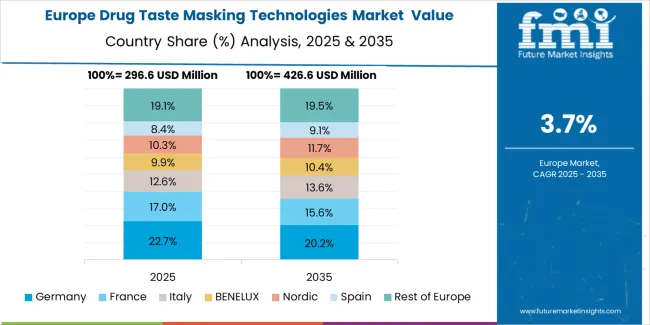
The drug taste masking technologies market in Europe is projected to grow from USD 316.7 million in 2025 to USD 419.1 million by 2035, registering a CAGR of 2.8% over the forecast period. Germany is expected to maintain its leadership position with a 25.8% market share in 2025, remaining at 25.0% by 2035, supported by its strong pharmaceutical excellence culture, sophisticated formulation capabilities, and comprehensive pharmaceutical sector serving diverse masking applications across Europe.
France follows with a 20.1% share in 2025, projected to reach 20.0% by 2035, driven by robust demand for pharmaceutical technologies in formulation applications, advanced pharmaceutical development programs, and masking enhancement markets, combined with established pharmaceutical infrastructure and technology integration expertise. Spain holds a 17.0% share in 2025, expected to reach 17.9% by 2035, supported by growing pharmaceutical activities. Italy commands a 9.5% share in 2025, projected to reach 9.8% by 2035, while BENELUX accounts for 4.1% in 2025, expected to reach 4.0% by 2035. Nordic Countries maintain a 2.1% share in 2025, declining to 2.0% by 2035. The Rest of Western Europe region is anticipated to maintain momentum, with its collective share moving from 21.4% to 21.3% by 2035, attributed to increasing pharmaceutical modernization and growing technology penetration implementing advanced masking programs.
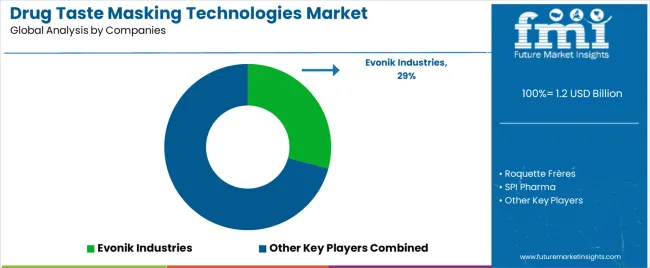
The drug taste masking technologies market is characterized by competition among established chemical companies, specialized pharmaceutical technology manufacturers, and integrated formulation solution providers. Companies are investing in formulation research, masking optimization, advanced pharmaceutical system development, and comprehensive technology portfolios to deliver consistent, high-quality, and application-specific masking solutions. Innovation in advanced coating integration, palatability enhancement, and pharmaceutical compatibility improvement is central to strengthening market position and competitive advantage.
Evonik Industries leads the market with a 29.2% market share, offering comprehensive masking solutions including quality formulation platforms and advanced coating systems with a focus on premium and pharmaceutical applications. Roquette Frères provides specialized ingredient capabilities with an emphasis on advanced masking implementations and innovative formulation solutions. SPI Pharma delivers comprehensive pharmaceutical services with a focus on integrated platforms and large-scale manufacturing applications. Adare Pharma Solutions specializes in advanced coating technologies and specialized masking implementations for premium applications. BASF SE focuses on pharmaceutical-oriented masking integration and innovative technology solutions.
The competitive landscape is further strengthened by companies like dsm-firmenich, which brings expertise in advanced flavor and fragrance technologies for specialized pharmaceutical applications. These companies continue to invest in research and development, strategic partnerships, and manufacturing capacity expansion to maintain their market positions and capture emerging opportunities in the growing drug taste masking technologies sector. The market benefits from continuous innovation in masking technologies, expanding pharmaceutical networks, and increasing manufacturing facility adoption of taste masking solutions.
| Item | Value |
|---|---|
| Quantitative Units (2025) | USD 1,226.3 million |
| Type | Taste-Masking Excipients; Coating Polymers; Encapsulation Materials; Processing Equipment; Services |
| Technology | Coating & Film-Barrier Systems; Microencapsulation; Hot-Melt Extrusion (HME); Organoleptic Methods; Others |
| End User | Pharmaceutical Manufacturers; CDMOs/CROs; Academic & Research Institutes; Biotechnology Companies; Others |
| Regions Covered | North America; Europe; East Asia; South Asia & Pacific; Latin America; Middle East & Africa |
| Countries Covered | USA; Germany; France; UK; Japan; China; India; South Korea; Brazil; and 40+ additional countries |
| Key Companies Profiled | Evonik Industries; Roquette Frères; SPI Pharma; Adare Pharma Solutions; BASF SE; dsm-firmenich |
| Additional Attributes | Dollar sales by type and technology category; regional demand trends; competitive landscape; technological advancements in formulation engineering; advanced masking development; pharmaceutical innovation; formulation integration protocols |
The global drug taste masking technologies market is estimated to be valued at USD 1.2 billion in 2025.
The market size for the drug taste masking technologies market is projected to reach USD 2.1 billion by 2035.
The drug taste masking technologies market is expected to grow at a 5.6% CAGR between 2025 and 2035.
The key product types in drug taste masking technologies market are coating & film-barrier systems , microencapsulation, hot-melt extrusion (hme), organoleptic methods and others.
In terms of type, taste-masking excipients segment to command 37.2% share in the drug taste masking technologies market in 2025.






Full Research Suite comprises of:
Market outlook & trends analysis
Interviews & case studies
Strategic recommendations
Vendor profiles & capabilities analysis
5-year forecasts
8 regions and 60+ country-level data splits
Market segment data splits
12 months of continuous data updates
DELIVERED AS:
PDF EXCEL ONLINE
Drug-Gene Interaction Panels Market Size and Share Forecast Outlook 2025 to 2035
Drug Testing Systems Market Size and Share Forecast Outlook 2025 to 2035
Drug Tester Market Size and Share Forecast Outlook 2025 to 2035
Drug Device Combination Products Market Size and Share Forecast Outlook 2025 to 2035
Drug Discovery Enzymes Market Size and Share Forecast Outlook 2025 to 2035
Drug Integrated Polymer Fibers Market Size and Share Forecast Outlook 2025 to 2035
Drug Discovery Outsourcing Market Size and Share Forecast Outlook 2025 to 2035
Drug Formulation Market Analysis - Size, Growth, & Forecast Outlook 2025 to 2035
Drug-Induced Dyskinesia Market Size and Share Forecast Outlook 2025 to 2035
Drug Free Depression Treatment Market Size and Share Forecast Outlook 2025 to 2035
Drug Delivery Technology Market is segmented by route of administration, and end user from 2025 to 2035
Drugs Glass Packaging Market Analysis - Size, Share, and Forecast Outlook 2025 to 2035
Drug Delivery Solutions Market Insights - Growth & Forecast 2025 to 2035
Drug Designing Tools Market Growth – Trends & Forecast 2025 to 2035
Drug of Abuse Testing Market Growth – Trends & Forecast 2025-2035
Drug-Induced Immune Hemolytic Anemia Market - Demand & Forecast 2025 to 2035
Drug Discovery Services Market Insights - Trends & Growth 2025 to 2035
Drug Screening Market Overview - Trends, Demand & Forecast 2025 to 2035
Drug Eruptions Treatment Market - Innovations & Future Outlook 2025 to 2035
Drug Discovery Informatics Market Trends - Growth & Future Outlook 2025 to 2035

Thank you!
You will receive an email from our Business Development Manager. Please be sure to check your SPAM/JUNK folder too.
Chat With
MaRIA